Tags
Liberty Media, LMCA, malone, media, music, SIRI, Sirius, SiriusXM, streaming, subscription
On February 17, 2009, SiriusXM Holdings Inc. (SIRI) found itself in dire straits. With the economy and particularly the new car market collapsing, SIRI was dangerously close to bankruptcy. The most urgent problem was a loan of $175 million due on February 18, which they simply did not have the cash to pay. Compounding the problem, the credit markets were frozen, thwarting any attempt to refinance the loan.
Luckily, John Malone’s Liberty Media Corp. rode to the rescue with a last minute emergency loan of $530 million. In return, Liberty primarily received Series B Preferred Shares. These preferred shares included a feature which enabled the holder to convert the preferred shares to common shares representing 40% of the ownership of SIRI. At time of the deal, SIRI stock was valued at $0.10 per share.
Liberty acted on the conversion feature in 2012.
Fast forward to 2015. SIRI is among the largest companies in subscription media (Figure 1). It has one of the highest EBIT margins in media (Figure 2). And it has been growing FCF at a 54% CAGR over the past 5 years (Figure 3).
Figure 1, Largest Subscription Media Businesses as of 2014
Figure 2, Highest EBIT Margins in Media 2014
Figure 3, SIRI FCF Growth 2010-2014
With the stock sitting at $3.90 per share, Liberty’s original $530 million investment is now worth approximately $8.8 billion – a mere 16 bagger for Mr. Malone. Further, SIRI is now healthy enough that on March 9th, it was able to issue $1 billion of notes at a 5.75% annual interest rate without a problem.
As we continue our march through the media industry, we next look at satellite radio company, SiriusXM Holdings (SIRI). Satellite radio is a radio service broadcast from satellites primarily to cars, with the signal broadcast nationwide, across a much wider geographical area than terrestrial radio stations. It is available by subscription, mostly commercial free, and offers subscribers more stations and a wider variety of programming options than terrestrial radio. After acquiring its rival XM in 2008, SIRI has a monopoly on satellite radio in the US.
Sirius has a very different business model than its sister company in the John Malone empire, Live Nation. Where Live Nation is a multi-sided platform company, Sirius has a subscription business model with a relatively small amount of advertising income (2% of 2014 revenue).[1] What are the strengths of SIRI that it was able to demonstrate such resilience and bounce back from its near-death experience?
The State of the Recorded Music Industry
Before we can fully understand SIRI, we need to understand the industry which it inhabits. The music industry had a relatively stable structure from approximately 1945 to the emergence of file sharing service Napster in 1999. The breakdown of the post-war order has been well chronicled elsewhere and does not need to be reiterated here. However, two characteristic of the current state of the music industry are relevant. First, demand for recorded music remains high. Americans spend an average of 4 hours a day consuming audio entertainment.[2] Second, the distribution of music is rapidly evolving from the sale of goods (records, tapes, CDs, MP3s) to a service. To be sure, the sale of physical goods plus the sale of digital downloads still represent the lion’s share of total US music industry revenue. But, streaming audio’s percentage is rapidly increasing . As the Harvard Business Review described it: “No longer do consumers want to build libraries or assets of music. Instead, music has become a service, one that has transformed the business that once operated on the basis of acquisition (essentially a capital expense) to one based on paying only for use (an operating expense).”
The digital music ecosystem that has emerged in the wake of the old order is complicated and crowded. Figure 4 below was created by SIRI in 2012 and is already hopelessly out-of-date. Among other things, it fails to include Jay-Z’s newly introduced Tidal service and probably 5 other companies that have risen and fallen in the past three years.[3]
Figure 4, The Digital Music Ecosystem Circa 2012
There are many ways of approaching the industry. I have decided to keep it simple and divide it into two groups: Free and Subscription.
Category #1 – Free of Charge, Ad-Driven Consumption Model
Today there is no shortage of ways for consumers to listen to and discover nearly the entirety of the world’s music for free. Unsurprisingly, consumers have reacted well to this. As a result, the one thing that really seems to be working in the digital music world is free. Free music is huge.
Of course, these services are not truly “free.” By “free,” I mean there is no charge to the consumer. Instead, these companies generate revenue through ad sales. This is a classic two-sided market. The platform company (e.g., the radio or streaming company) must attract listeners on one side of the market and advertisers on the other. When it works well, a positive feedback loop is created whereby more listeners attract more advertisers which generate more cash to acquire content which attracts more listeners, etc.
Who are the major players among free music services?
Terrestrial (AM/FM) Radio Still Dominates
For all the changes, old-fashioned, advertising-supported terrestrial radio remains the #1 source of audio entertainment in the US. There are 200 million people who listen to terrestrial radio every day. Radio advertising remains 11% of the overall US advertising market and hit $17 billion in 2014.
Why does terrestrial radio remain so popular and immune to disruption? Terrestrial radio providers offer their content for free, are well established and accessible to listeners and offer content beyond music including news, comedy, sports, traffic, weather and talk. Further, radio remains fundamentally local. Local DJs create a connection with the audience and are effective pitchmen for products. Local radio can provide companionship and connect people with news and information about their local communities. Most importantly, AM/FM radios have been standard in cars for years and years. They own the very valuable in-dash real estate.
Further, these companies enjoy reduced expense because, due to a quirk of history, terrestrial radio does not have to pay royalties to music publishers when a song is played. As we shall see, content acquisition costs burden some of the competitors.
YouTube – Biggest Source of Audio Entertainment Globally?
YouTube, a unit of Google, offers free music videos and audio-only songs, albums, and playlists for on-demand streaming. The site is supported by advertising revenue. Google does not provide audience numbers or advertising revenue, but YouTube is believed to be the biggest source of audio entertainment globally.
Free Streaming Music Services
The free streaming services such as Spotify, Pandora, IHeartRadio, Apple’s iTunes Radio and others have had no problem attracting listeners. (See Figure 5.) However, they have had trouble monetizing them via ad sales. These music only streaming services have several problems with their business model. First and foremost, the industry has low barriers to entry and little differentiation. Free music has become commoditized. The difference between the services in quite limited and, for the most part, they do not have exclusive content (Tidal being an important new exception). I have used all of the major services and while all have their own pros and cons, none rises above the crowd. Second, there are no switching costs. Over the past few days, I flit about amongst Spotify, Pandora, IHeartRadio, and Rdio. There is absolutely no cost to doing so.
Figure 5, 2014 Registered Users for Major Free Music Services
Category #2 – Subscription-Based Consumption Model
The most common alternative in the media world (other than live performance) to the ad-driven model is the subscription model. The subscription model has many advantages over the ad-based model – and, indeed, significant advantages over most other business models. What is a subscription model?
A “subscription business model” refers to a business which generates revenue via customer payments at fixed intervals (e.g., monthly, yearly, or seasonal) to access the business’ products or services. This is in contrast to traditional businesses which sell their product or service individually and generate revenue via one-time payments. This payment model was pioneered by magazine and newspaper publishers, but is now used by a growing number of businesses. The subscription model is particularly prominent among online companies including cloud storage companies, photo sharing, social media and online games and music.
Highly Measurable
The defining characteristic of a subscription-based model is that the acquisition and departure of a customer is observed – unlike, for example, conventional retailers. In fact, because a subscription typically constitutes a contractual agreement, the vendor knows at any point in time the number of currently active customers. Since the company knows at any point who is still an active customer and who has recently departed, this type of customer data tracking is relatively simple.
What can the data tell us about a subscription business?
The first key data point is Subscriber Acquisition Costs (SAC). SAC is the quarterly sales and marketing expense for a company and divided by the number of new customers acquired in the quarter. But how do we know if that SAC is worth it — or whether the company is simply spending too much money to acquire customers that will never yield a positive financial return?
To answer this question, we need to look at the lifetime expected earnings of that customer or Customer Lifetime Value (LTV), which is calculated by (Annual Recurring Revenue x Gross Margin) ÷ (% Churn + Discount Rate). If the LTV is close to or less than SAC, then we know that something is out of balance; it suggests that the company is spending more money to acquire the customer than it expects to generate in profits over the customer’s lifetime. This could be because the company hasn’t figured how to effectively monetize its customers. Or that customers are leaving before they’ve spent enough money on the platform to cover the costs to acquire them. Or that the company hasn’t figured out an effective way to scale its subscriber acquisition costs.
A third data point is Churn. Churn is the number of customers lost during a time frame, such as a month, and divided by the total number of customers in place at the beginning of the month. You do not include any new sales from that month. By comparing a company’s churn to its peers, we can gauge relative customer satisfaction.
Finally, an another important data point is unearned or deferred revenue. Subscription companies only get to recognize revenue over the term of the deal as the service is delivered. Where, then, does that “booking” go? In most cases, it goes onto the balance sheet in a liability line item called deferred revenue. (Because the balance sheet has to “balance,” the corresponding entry on the assets side of the balance sheet is ‘cash’ if the customer pre-paid for the service or ‘accounts receivable’ if the company expects to bill for and receive it in the future). As the company starts to recognize revenue from the service, it reduces its deferred revenue balance and increases revenue — so for a 24-month deal, as each month goes by deferred revenue drops by 1/24th and revenue increases by 1/24th. As a practical matter, this means that the subscription provider is receiving cash before it incurs expense to serve the customer. Effectively, the business is receiving interest-free loans from its customers to finance the business. This low cost financing frees up other cash to be used for dividends, share buy-backs and other needs.
Visibility and Predictability
Recurring revenue is the portion of a company’s revenue that is highly likely to continue in the future. This is revenue that is predictable, stable and can be counted on in the future with a high degree of certainty.
For example, a cable company that has millions of customers paying monthly could consider a large portion of its monthly revenues to be recurring in nature. Many market pundits consider recurring revenue to be a highly desirable quality for a company to have.
Visibility and predictability are highly valued by investors. Investors favor pricing models that provide a high level of predictability and consistency in the future. The more certain you can be of future cash flows when preparing a DCF analysis, the higher premium you will put on a business.
Subscription revenue is highly predictable. Recurring payments from a subscriber base ensures a steady flow of repeat business. Businesses benefit because they are assured a predictable and constant revenue stream from subscribed individuals for the duration of the subscriber’s agreement. Not only does this greatly reduce uncertainty and the riskiness of the enterprise
Benefits of Scale
At scale, subscription revenue provides a predictable, recurring source of funds for content acquisition. The more people that pay for the subscription, the more money that the business will have to fund content to please more subscribers. It is particularly advantageous to the economics of the subscription business if the content is very expensive to buy and is also exclusive to the service.
Frictionless Billing
Renewal of a subscription may be periodic and activated automatically, so that the cost of a new period is automatically paid for by a pre-authorized charge to a credit card or a checking account. Simple, automatic payments
Stickiness/Customer Inertia
Customers become greatly attached to using the service and, therefore, more likely to extend by signing an agreement for the next period close to when the current agreement expires. Subscribers are also subject to the sunk cost fallacy. That is, many people have strong misgivings about “wasting” resources (loss aversion). In other words, if they are paying for it, they are going to use it, even if perfectly good free alternatives are available.
High Switching Costs
Anyone who has spent time on the phone with a customer service rep trying to turn off cable service or Sirius service knows well the potential switching costs associated with cancelling most subscription-based businesses. Cable and home security companies are notorious for trying to keep customers in long-term contracts to keep them from switching. One way to keep customers is to make the payment system easy. Automatic payments work for subscription based services like Netflix and other deliverers of online content that tie in customers through credit cards and other continuous payment systems.
Nevertheless, customers can leave at any time with no penalty.
High Cash Generation
The subscription model leads to a high rate of converting accounting earnings to cash. The subscription model means that they collect cash from customers long before they have to pay suppliers. As described above, the revenue can’t be booked at the time the cash is collected. Instead, it gets hung up on the balance sheet as deferred revenue.
Unique Characteristics of the SIRI Model
SIRI has a number of unique characteristics that give it advantages over the run-of-the-mill subscription business. For those unfamiliar with the Sirius XM subscription model, the company has agreements with OEMs to place satellite radios in nearly 70% (the company’s penetration rate) of new vehicles sold in the US. Sirius XM subsidizes the cost of the hardware and the purchasers (or lessees) of those vehicles receive a free trial to experience the benefits of the satellite radio service for a period that typically lasts for three to twelve months. At the end of the trial period, the objective is to “convert” the owner to a paying subscriber – or what the company terms a “self-pay subscriber.” Sirius is successful about 41% of the time in these efforts with new car buyers.
Valuable In-Car Real Estate
Anything that makes it easier for the consumer and reduces friction is a benefit for any company providing consumer services. As 40-50% of audio listening happens in the car, it’s incredibly important to audio entertainment companies to be fully integrated into the dashboard. This is central to the success of terrestrial radio. SIRI with 70% penetration is close behind. Competitors like Pandora dream about getting their hands on the valuable in-car real estate.[4]
Minimal Capital Requirements
Satellite is an attractive business because it’s actually relatively asset-light compared to Cable and Telco fiber. A mini-dish and set-top box for every home, several broadcast stations, call centers and a few strategically positioned satellites is all that is needed to run a ubiquitous satellite TV company. By contract, cable companies need a ton of coaxial fiber or fiber optic line for every home or business. And the cable needs constant upgrading every several years in order to remain competitive.
Economies of Scale
SIRI owns a fleet of nine orbiting satellites, five in the Sirius system, FM-1, FM-2, FM-3, FM-5 and FM-6, and four in the XM system, XM-1, XM-3, XM-4 and XM-5. These are SIRI’s primary fixed assets and are highly scalable at a low incremental cost. SIRI’s next customer will be its most profitable customer.
SIRI is able to spread its fixed costs (content acquisition, marketing/advertising, satellites) over a large subscriber base. As a result, it has the benefit of economies of scale. Each new customer it adds is extremely profitable (See Figure 6.)
Figure 6, Lifetime Value of a SIRI Customer
Subscription-Based Streaming Models – Is The Business Model Sustainable?
Most of the free services listed above also offer a paid premium tier.[5] The streaming competitors have found the economics of their two tier approaches to be challenging (See Figure 7).
Figure 7, Economics of Subscription Streaming Media
First and foremost, the streamers have found it difficult to convert listeners to paid subscriptions. Consumers, and particularly the post-Napster generation, have become accustomed to free music. While the premium tier offers no advertising and enhanced personalization, these drawbacks do not seem to be motivating sufficient people to switch from free. A substantial portion of the market seems to think the free tiers are “good enough.”
Second, the cost structure of the industry is deeply troublesome. Unlike terrestrial radio, which does not pay royalties to the music publishers for the right to play music, to stream music content over the Internet, companies including Pandora, must pay royalties on a per play basis. The per play rate is established every 5 years by the CRB Copyright Royalty Board (CRB), a 3 person panel which sets rates. The CRB has met 3 times before, and has never lowered rates. The last time they met, they set rates so exorbitantly high that there needed to be a workaround side agreement to operate under, or else every industry player might have gone bankrupt. Expectations are high for a more favorable resolution at the latest iteration, called Web IV, the results of which will be announced this December. But, any increase in rates would be catastrophic to Pandora’s model.
Third, competition is increasing in an already fragmented market. Further, the newest entrant, Tidal, has signaled that it will arrange exclusive relationships with artists. Thus, Taylor Swift’s catalog which was pulled from Spotify in protest will be exclusively available on Tidal. Does this signal the beginning of a destructive arms-race where the streamers spend lots of money on exclusive deals? Or will there be scale benefits and the market will tip in a winner take all scenario? Only time will tell I am afraid.
How Can SIRI Compete With Free?
It’s hard to compete when low barriers to entry enable dozens of competitors to make a comparable product and give it away for free. Music alone is not enough. The ubiquitous availability of music, especially for free on terrestrial radio, requires compelling non-music programming that consumes can’t get elsewhere. “Talent is what drives this world. There is no Sirius without talent. Doesn’t matter how many satellites you f—ing stick in the air,” said Howard Stern on his radio show. Stern is right of course. Nobody has any loyalty to the Sirius brand separate and apart from the content the company provides. In fact, it was the acquisition of Stern himself that put Sirius on the map and paved the way for the merger between Sirius and XM that gave Sirius its current monopoly on satellite radio.[6] It is the content that drives the Sirius flywheel. It has exclusive content and commercial free music, curated in many categories that interests our customers, whether it be Howard Stern, or whether it be MLB, or whether it be CNBC or the EDM channel, or the Jazz channel, something for everybody As stated at the beginning, It is exclusive non-music content is what truly distinguishes SIRI from its competitors and allows the company to compete vigorously with new market entrants. Obviously, if a consumer can only obtain desired programming from an outlet, then the consumer is more likely to pay to receive that programming and other programming from that outlet.
Growth
SIRI has several growth drivers available to it.
Continued Subscriber Growth
The big picture is very favorable for SIRI. The CEO, Jim Meyer, recently explained this dynamic in a commonsensical manner: “A really, really easy way to think about this — there’s 240 million cars in the United States. Take out fleets and collectors, gets you down to about 200 million. If I came to you and said I have a great idea for a premium product and I think I can sell it to 15% or 20% of the audience out there, I think you would see that’s a reasonable goal.”[7] At the end of 2014, SIR had 27 million subscribers or about 13.5% of the total market. Is it crazy to think they could get to 15% or 20%? I don’t think so. An increase to 20% would mean 13 million more subscribers or almost $2 billion more in revenue (assuming no price increases) with incredible operating leverage.
To be sure, the growth of the new car market is slowing. As the penetration rate increases (now up to 70%), the conversion rate has slowed. This is because satellite radios are being installed in cheaper cars being bought by people outside SIRI’s target demographic. With a stable penetration rate in the new car market and moderating new car sales, subscriber growth for Sirius XM is getting stagnant. See Figure 8.
Figure 8, SIRI Subscriber Growth 2010-2014
What will make up the difference? The lowest hanging fruit available to Sirius would seem to be the installed base of satellite radio equipped cars currently on the road. Given the average ownership of a new vehicle, in 2-3 years there will be 100 million cars which are Sirius enabled. If we assume that there will be 30 million subscribers at that time, then there will be 70 million additional SIRI radios out there. It does not seem unreasonable to believe that SIRI could convert a significant number of these equipped cars to subscribers.
Pricing Power
SIRI subscribers are very loyal to the product. As can be seen in Figure 9 below, as SIRI increased prices over the past few years, churn is flat to down in every case. Despite this demonstrated loyalty, the CFO does not expect top line growth to be driven primarily by pricing gains: “I think satellite radio you should think of like any other media property out there. I think it will generally have a rising value over time and so our subscription price will go up gently over time.”[8] SIRI seems to value volume increases and stable churn to price increases.
Figure 9, SIRI Pricing Power
Continued Margin Expansion
SIRI’s high fixed costs and economies of scale result in FCF growing much faster than revenue. Over the past 5 years, FCF has grown at 54% versus just 10% for revenue.
We believe SIRI’s margins will continue to expand over time, as they have steadily over the past five years
Power of Levered Share Repurchases
Do not under-estimate the impact of the share buy-back program. The number of diluted shares outstanding has dropped by 15% over the past two years. Ongoing equity shrink combined with financial outperformance leads to significant long-term value creation. As of December 31, 2014 cumulative repurchases since December 2012 totaled 1.3 billion shares for $4.3 billion, and $1.7 billion remains available under the stock repurchase program. As shown below, using cash to repurchase SIRI’s stock results in a significant increase in FCF per share.
Figure 10, FCF Per Share Growth 2010-2014
The Connected Car – Problem or Opportunity?
The connected car is a car equipped with Internet connections and software that allows people to stream music, look up movie times, be alerted of traffic and weather conditions, and maintenance needs. SIRI made a major investment in connected car technology with its 2013 acquisition of Agero Corp. for $525 million.
Will the connected car disrupt SIRI’s business the way SIRI disrupted terrestrial radio?
This seems unlikely. First off, today car owners can get much of the connected car experience by simply tethering their smartphone to their car. Currently, there are over 150 million smartphones in the US. So, SIRI has been competing against them for quite some time without a dramatic impact on their results.
However, the next generation of the connected car will be much easier to use. It will be completely embedded into the dash of the car. But even if you believe SIRI loses this phase of the competition, it will take a long time to roll out. It took SIRI years and years to get to its current level of 12 million new car installations per year. How long will it take the connect car technology?
Valuation
Sirius’ business model creates an annuitized stream of cash flows. We think about the stability of these cash flows similarly to REITS, utilities, MLPS, and best-in-class consumer staples companies. Our valuation approach for such companies is very simple. We take the steady state cash flow from operations less the recurring capital expenditures used to maintain the quality of Sirius’ underlying assets. The result is steady state FCF. Divide steady-state FCF by Enterprise Value (EV) to get FCF yield. Then add a percentage for growth opportunities and return on investment.
Here, steady state FCF is $1,131,598,000. EV is $26,866,918,000 (See Figure 11.) This gives a steady state FCF yield of 5%. Then we look at growth. The key drivers are (1) the number of cars on the road, (2) the percent that subscribe, and (3) the ARPU. In 10 years, even if we assume a very small 10% increase in the number of cars on the road to 220 million, the subscription rate increases from 13.5% to 20%, and ARPU stays flat at $12.38, we get $6 billion of revenue. Assuming conservatively that there is limited operating leverage and the FCF margin increase to 30% from 27%, this produces $1.9 billion of FCF. Thus, without any heroic assumption, we arrive at an attractive 10% FCF yield. Note that this assumes no benefit from share buyback.
Figure 11, Calculation of Enterprise Value
Of course, the positive characteristics of the SIRI model are all sub-sets of risk reduction. As is so often the case with the companies, a key issue is how much of a premium are you willing to pay for reduced risk? It is not a secret that recurring revenue + fixed cost leverage = superior cash flow. In the current environment, investors have not bid up the price of low-risk equities to high levels as during the “Nifty Fifty” bubble of the late 1960s. Neither are they shunning them as hopelessly stodgy or otherwise unattractive. It is my sense that investors are somewhat risk tolerant at this point in time and are not willing to pay high premiums for safety (or the appearance of safety).
[1] I don’t want to get to caught up in the terminology but Sirius is sometimes mistakenly referred to as a two-side platform company. See here. In this view, customers and content are viewed as the two sides. I think this is wrong and misleading. As stated previously, customers and advertisers can form a two-sided market but Sirius generates little revenue from advertising. Collecting subscription fees from customers to access content is not a two-sided market.
[2] http://www.edisonresearch.com/edison-research-conducts-first-ever-share-of-ear-measurement-for-all-forms-of-online-and-offline-audio/
[3] Here is a seemingly up to date overview of the entire music marketplace: http://whymusicmatters.com/find-music
[4] For example, Pandora CFO: “We’ve had over 9.5 million people integrate or activate Pandora within a native integration in the dash. Those people, on average listen to Pandora 20% more after doing the integration.” Pandora Media Inc at JMP Securities Technology Conference March 2, 2015.
[5] Apple and YouTube are key exceptions to this approach. Apple is trying to drive music purchases from iTunes and it has not been particularly successful in doing so. I am not clear on what Google’s digital music strategy is.
[6] Can SIRI survive should Stern retire or sign with a competitor? In January 2014, Macquarie surveyed 800 SiriusXM subscribers and found that while SiriusXM is available on the go for premium subscribers via Web and mobile apps, 84 percent of listening takes place in cars. Of the respondents, 12 percent said they listen to Stern—the equivalent of about 3.2 million listeners. Five percent said they’d consider leaving SiriusXM if Stern departed. A rough estimate suggests it could cost the company about $240 million in lost revenue annually if he left. For a company that generated $4.2 billion in revenue last year, that would be a substantial blow—but hardly crippling.
[7] Liberty Media Corp. Investor Day Presentation, November 19, 2014.
[8] Sirius XM Holdings Inc at JPMorgan Global High Yield & Leveraged Finance Conference
Feb 23, 2015.

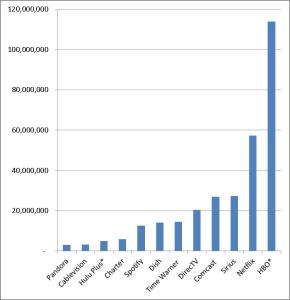
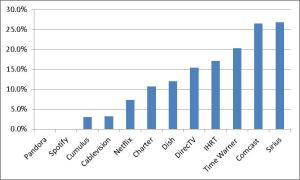

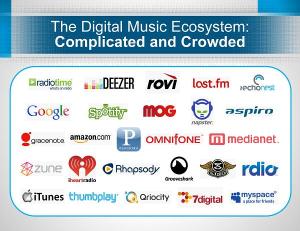
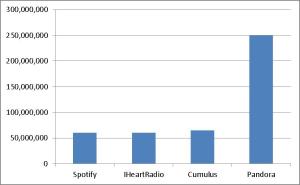
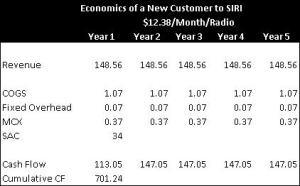
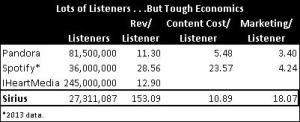


Enjoyed your post.
I know that you address connected car, but I think you understate the risks to Sirius.
It seems to me that the connected car will use the smart phone as its base. As cars now offer wireless data plans and will streaming of apps and music through the console, I wonder why anyone would want to pay for Sirius when they could simply stream Pandora/Spotify/etc. which they may already be paying for.
Just my $0.02
I completely understand your point and perhaps I under-estimated this risk. The in-dash real estate is definitely valuable. These other companies will enhance their competitive position if they can be accessed through the console. But, (1) it will take years to roll this out and (2) it is exclusive content and not music that attracts subscribers to SIRI.
Enjoyed the write up. You addressed deferred revenue but also looks like SIRI has $1.8bn of NOLs. They haven’t paid cash taxes for the last couple of years and presumably won’t pay any for the next while. Any thoughts on this?
Its a fair point. I am actually a tax attorney by day and I am well aware of the benefit of NOLs. I decided not to discuss the NOLs because the benefit is relatively short term. I believe they expect to start paying tax again in 2017.
As you rightly point out the music industry has undergone significant transformation recently such that even a chart of the competitive landscape from 3 years ago is already dated.
Given the rapidly changing landscape and evolving technologies and business models how can you be confident that This business will enjoy the same competitive position in 5 or 10 years time and won’t fall victim to yet another shift in the industry structure?
Its a very fair point. Uncertainty about the future is at the heart of the bear case. I thought I addressed this in my post but I will summarize the argument here:
1. SIRI has been competing against smart phones for quite some time with no discernible impact.
2. Pandora and the others will undoubtedly receive a boost when their product is integrated into the dash rather than requiring a smart phone. But, this will take years to be fully rolled out.
3. Pandora and the others are exclusively music-based right now. Music has become commoditized. SIRI develops customer loyalty through exclusive programming which the competitors do not have.
4. One point I did not make but I saw elsewhere is that the connected car requires an Internet connect. Right now, mobile Internet connections are quite expensive and come with data limits.
So, when weighing these factors, I think the risk is present but manageable.
Pingback: John Malone and His Cable/Media Empire
Hi, I’m relatively new to this space so apologies if this is an ignorant question, but why not buy LMCA instead of SIRI?
No reason. I just thought it was important to understand each company in the LMCA portfolio before valuing LMCA.
Pingback: Charter: John Malone’s Return to The US Cable Industry | Punch Card Investing